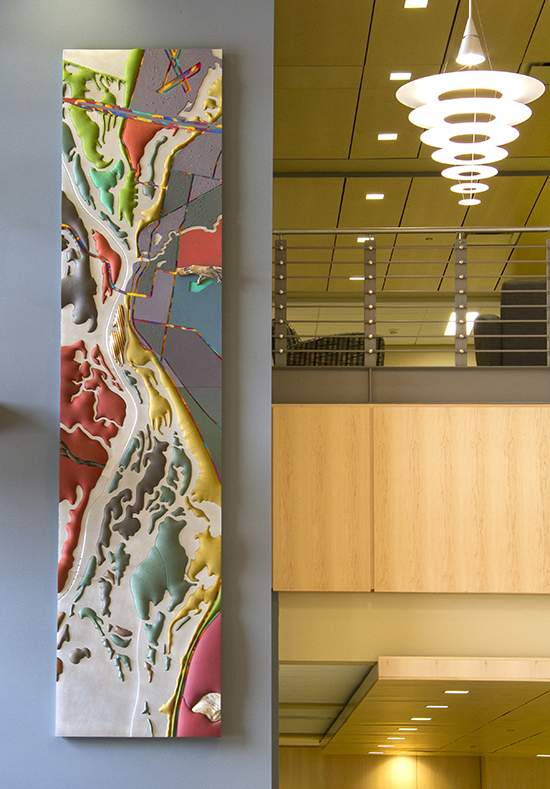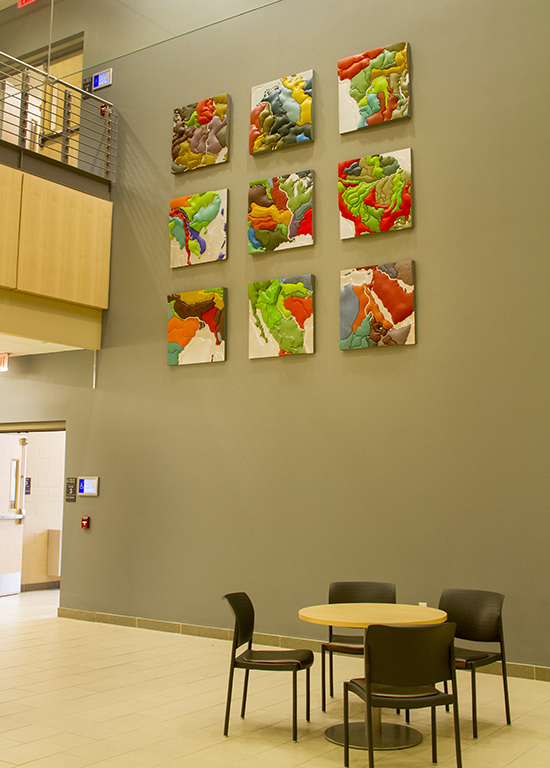Posted 8:54 p.m. Thursday, Feb. 28, 2013

New artwork in Centennial Hall yields a variety of interpretations that resonate with the campus community: diversity, globalism, sustainability and the nature of a college education — a place where many different people and ideas come together.
 [/caption]
Artwork in Centennial Hall depicts rivers from around the world, but it has a message that hits home. The collection of abstract wall-mounted sculptures titled “Confluence” yields a variety of interpretations that resonate with the campus community: diversity, globalism, sustainability and the nature of a college education — a place where many different people and ideas come together.
The final pieces of the art collection were installed in Centennial Hall at the end of February.
Two, large wall-mounted sculptural works in the main lobby are drawn from maps of the river region around La Crosse. One depicts about 58 miles along the Mississippi River’s main channel from Winona to just south of the Iowa border. The second renders a closer view of the area around La Crosse, including the confluence of the Mississippi, Black and La Crosse rivers. It also includes a mapping of the location of the UW-La Crosse campus. Both of these map artworks are derived from the Corps of Engineers Upper Mississippi River Navigation Charts.
[caption id="attachment_21175" align="alignright" width="356" caption="These nine smaller works located at the atrium connecting Centennial’s third and fourth floors expand upon the idea of confluence and global diversity."]
[/caption]
Artwork in Centennial Hall depicts rivers from around the world, but it has a message that hits home. The collection of abstract wall-mounted sculptures titled “Confluence” yields a variety of interpretations that resonate with the campus community: diversity, globalism, sustainability and the nature of a college education — a place where many different people and ideas come together.
The final pieces of the art collection were installed in Centennial Hall at the end of February.
Two, large wall-mounted sculptural works in the main lobby are drawn from maps of the river region around La Crosse. One depicts about 58 miles along the Mississippi River’s main channel from Winona to just south of the Iowa border. The second renders a closer view of the area around La Crosse, including the confluence of the Mississippi, Black and La Crosse rivers. It also includes a mapping of the location of the UW-La Crosse campus. Both of these map artworks are derived from the Corps of Engineers Upper Mississippi River Navigation Charts.
[caption id="attachment_21175" align="alignright" width="356" caption="These nine smaller works located at the atrium connecting Centennial’s third and fourth floors expand upon the idea of confluence and global diversity."] [/caption]
Nine smaller works located at the atrium connecting Centennial’s third and fourth floors expand upon the idea of confluence and global diversity. They depict culturally-important rivers of the world in square compositions focusing on the watersheds of each river and its passage to the sea. These artworks emphasize the natural contours of the land and water. At first glance, each of these works appears more similar than different; the Amazon, the Mississippi and the Congo share the characteristic forms of headwaters, tributaries and deltas, and it is only upon closer examination that the individual identity of each river is revealed. The rivers depicted in the small compositions include the Amazon, Congo, Nile, Volga, Rhine, Mississippi, Rio Grande, Euphrates, Ganges, Mekong and Yangtze.
Some materials used in the artwork are locally-sourced, including the use of salvaged and reclaimed materials from the region such as driftwood, native mussel shells from the Mississippi River, lumber from a woodlot in Pepin County and salvaged lumber from a Stockholm, Wis., village park.
Artists from The Myklebust+Sears Studio in Pepin County, Andrea Myklebust and Stanton Sears, created the pieces. The works were funded by the state’s Percent-for-Art program.
[/caption]
Nine smaller works located at the atrium connecting Centennial’s third and fourth floors expand upon the idea of confluence and global diversity. They depict culturally-important rivers of the world in square compositions focusing on the watersheds of each river and its passage to the sea. These artworks emphasize the natural contours of the land and water. At first glance, each of these works appears more similar than different; the Amazon, the Mississippi and the Congo share the characteristic forms of headwaters, tributaries and deltas, and it is only upon closer examination that the individual identity of each river is revealed. The rivers depicted in the small compositions include the Amazon, Congo, Nile, Volga, Rhine, Mississippi, Rio Grande, Euphrates, Ganges, Mekong and Yangtze.
Some materials used in the artwork are locally-sourced, including the use of salvaged and reclaimed materials from the region such as driftwood, native mussel shells from the Mississippi River, lumber from a woodlot in Pepin County and salvaged lumber from a Stockholm, Wis., village park.
Artists from The Myklebust+Sears Studio in Pepin County, Andrea Myklebust and Stanton Sears, created the pieces. The works were funded by the state’s Percent-for-Art program.